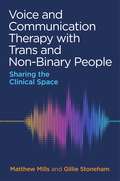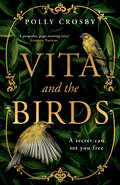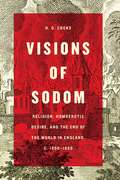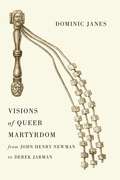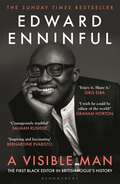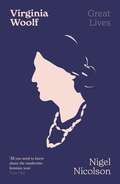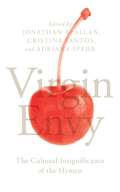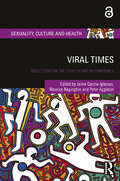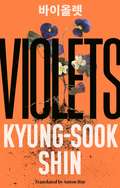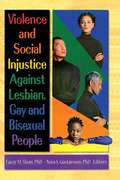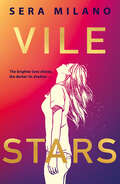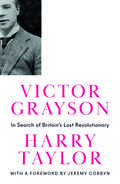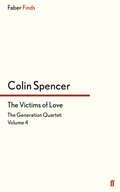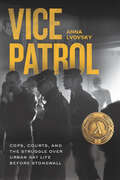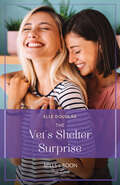- Table View
- List View
Voice and Communication Therapy with Trans and Non-Binary People: Sharing the Clinical Space
by Matthew Mills Gillie StonehamSpecifically aimed at Speech and Language Therapists (SLTs) and voice practitioners, this book follows up from the authors' first book, The Voice Book for Trans and Non-Binary People. It sets out cultural competence, psychological and vocal skills, group activities and improvisations frameworks and exercises to helps SLTs develop their skills for working with trans and non-binary clients, including facilitation and coaching, emotional intelligence, role-play and solution-focused therapy, narrative therapy practices. It also includes many contributions from the trans community and a range of clinical professionals to emphasise the collaborative space.Written by two leading authorities on voice and communication therapy for trans people, this is an essential and authoritative resource for anyone working with trans and non-binary clients who are seeking their voice exploration.
Vita and the Birds
by Polly CrosbyA haunting mystery for fans of Eve Chase, Kate Morton and Kate Mosse. ‘A poignant page-turning story, beautifully written’ Leonora Nattrass, author of Blue Water ’Hugely evocative and beautifully written’ Anna Mazzola, author of The Clockwork Girl
Visions of Sodom: Religion, Homoerotic Desire, and the End of the World in England, c. 1550-1850
by H. G. CocksThe book of Genesis records the fiery fate of Sodom and Gomorrah—a storm of fire and brimstone was sent from heaven and, for the wickedness of the people, God destroyed the cities “and all the plains, and all the inhabitants of the cities, and that which grew upon the ground.” According to many Protestant theologians and commentators, one of the Sodomites’ many crimes was homoerotic excess. In Visions of Sodom, H. G. Cocks examines the many different ways in which the story of Sodom’s destruction provided a template for understanding homoerotic desire and behaviour in Britain between the Reformation and the nineteenth century. Sodom was not only a marker of sexual sins, but also the epitome of false—usually Catholic—religion, an exemplar of the iniquitous city, a foreshadowing of the world’s fiery end, an epitome of divine and earthly punishment, and an actual place that could be searched for and discovered. Visions of Sodom investigates each of these ways of reading Sodom’s annihilation in the three hundred years after the Reformation. The centrality of scripture to Protestant faith meant that Sodom’s demise provided a powerful origin myth of homoerotic desire and sexual excess, one that persisted across centuries, and retains an apocalyptic echo in the religious fundamentalism of our own time.
Visions of Sodom: Religion, Homoerotic Desire, and the End of the World in England, c. 1550-1850
by H. G. CocksThe book of Genesis records the fiery fate of Sodom and Gomorrah—a storm of fire and brimstone was sent from heaven and, for the wickedness of the people, God destroyed the cities “and all the plains, and all the inhabitants of the cities, and that which grew upon the ground.” According to many Protestant theologians and commentators, one of the Sodomites’ many crimes was homoerotic excess. In Visions of Sodom, H. G. Cocks examines the many different ways in which the story of Sodom’s destruction provided a template for understanding homoerotic desire and behaviour in Britain between the Reformation and the nineteenth century. Sodom was not only a marker of sexual sins, but also the epitome of false—usually Catholic—religion, an exemplar of the iniquitous city, a foreshadowing of the world’s fiery end, an epitome of divine and earthly punishment, and an actual place that could be searched for and discovered. Visions of Sodom investigates each of these ways of reading Sodom’s annihilation in the three hundred years after the Reformation. The centrality of scripture to Protestant faith meant that Sodom’s demise provided a powerful origin myth of homoerotic desire and sexual excess, one that persisted across centuries, and retains an apocalyptic echo in the religious fundamentalism of our own time.
Visions of Sodom: Religion, Homoerotic Desire, and the End of the World in England, c. 1550-1850
by H. G. CocksThe book of Genesis records the fiery fate of Sodom and Gomorrah—a storm of fire and brimstone was sent from heaven and, for the wickedness of the people, God destroyed the cities “and all the plains, and all the inhabitants of the cities, and that which grew upon the ground.” According to many Protestant theologians and commentators, one of the Sodomites’ many crimes was homoerotic excess. In Visions of Sodom, H. G. Cocks examines the many different ways in which the story of Sodom’s destruction provided a template for understanding homoerotic desire and behaviour in Britain between the Reformation and the nineteenth century. Sodom was not only a marker of sexual sins, but also the epitome of false—usually Catholic—religion, an exemplar of the iniquitous city, a foreshadowing of the world’s fiery end, an epitome of divine and earthly punishment, and an actual place that could be searched for and discovered. Visions of Sodom investigates each of these ways of reading Sodom’s annihilation in the three hundred years after the Reformation. The centrality of scripture to Protestant faith meant that Sodom’s demise provided a powerful origin myth of homoerotic desire and sexual excess, one that persisted across centuries, and retains an apocalyptic echo in the religious fundamentalism of our own time.
Visions of Sodom: Religion, Homoerotic Desire, and the End of the World in England, c. 1550-1850
by H. G. CocksThe book of Genesis records the fiery fate of Sodom and Gomorrah—a storm of fire and brimstone was sent from heaven and, for the wickedness of the people, God destroyed the cities “and all the plains, and all the inhabitants of the cities, and that which grew upon the ground.” According to many Protestant theologians and commentators, one of the Sodomites’ many crimes was homoerotic excess. In Visions of Sodom, H. G. Cocks examines the many different ways in which the story of Sodom’s destruction provided a template for understanding homoerotic desire and behaviour in Britain between the Reformation and the nineteenth century. Sodom was not only a marker of sexual sins, but also the epitome of false—usually Catholic—religion, an exemplar of the iniquitous city, a foreshadowing of the world’s fiery end, an epitome of divine and earthly punishment, and an actual place that could be searched for and discovered. Visions of Sodom investigates each of these ways of reading Sodom’s annihilation in the three hundred years after the Reformation. The centrality of scripture to Protestant faith meant that Sodom’s demise provided a powerful origin myth of homoerotic desire and sexual excess, one that persisted across centuries, and retains an apocalyptic echo in the religious fundamentalism of our own time.
Visions of Queer Martyrdom from John Henry Newman to Derek Jarman
by Dominic JanesWith all the heated debates around religion and homosexuality today, it might be hard to see the two as anything but antagonistic. But in this book, Dominic Janes reveals the opposite: Catholic forms of Christianity, he explains, played a key role in the evolution of the culture and visual expression of homosexuality and male same-sex desire in the nineteenth and twentieth centuries. He explores this relationship through the idea of queer martyrdom—closeted queer servitude to Christ—a concept that allowed a certain degree of latitude for the development of same-sex desire. Janes finds the beginnings of queer martyrdom in the nineteenth-century Church of England and the controversies over Cardinal John Henry Newman’s sexuality. He then considers how liturgical expression of queer desire in the Victorian Eucharist provided inspiration for artists looking to communicate their own feelings of sexual deviance. After looking at Victorian monasteries as queer families, he analyzes how the Biblical story of David and Jonathan could be used to create forms of same-sex partnerships. Finally, he delves into how artists and writers employed ecclesiastical material culture to further queer self-expression, concluding with studies of Oscar Wilde and Derek Jarman that illustrate both the limitations and ongoing significance of Christianity as an inspiration for expressions of homoerotic desire. Providing historical context to help us reevaluate the current furor over homosexuality in the Church, this fascinating book brings to light the myriad ways that modern churches and openly gay men and women can learn from the wealth of each other’s cultural and spiritual experience.
Visions of Queer Martyrdom from John Henry Newman to Derek Jarman
by Dominic JanesWith all the heated debates around religion and homosexuality today, it might be hard to see the two as anything but antagonistic. But in this book, Dominic Janes reveals the opposite: Catholic forms of Christianity, he explains, played a key role in the evolution of the culture and visual expression of homosexuality and male same-sex desire in the nineteenth and twentieth centuries. He explores this relationship through the idea of queer martyrdom—closeted queer servitude to Christ—a concept that allowed a certain degree of latitude for the development of same-sex desire. Janes finds the beginnings of queer martyrdom in the nineteenth-century Church of England and the controversies over Cardinal John Henry Newman’s sexuality. He then considers how liturgical expression of queer desire in the Victorian Eucharist provided inspiration for artists looking to communicate their own feelings of sexual deviance. After looking at Victorian monasteries as queer families, he analyzes how the Biblical story of David and Jonathan could be used to create forms of same-sex partnerships. Finally, he delves into how artists and writers employed ecclesiastical material culture to further queer self-expression, concluding with studies of Oscar Wilde and Derek Jarman that illustrate both the limitations and ongoing significance of Christianity as an inspiration for expressions of homoerotic desire. Providing historical context to help us reevaluate the current furor over homosexuality in the Church, this fascinating book brings to light the myriad ways that modern churches and openly gay men and women can learn from the wealth of each other’s cultural and spiritual experience.
Visions of Queer Martyrdom from John Henry Newman to Derek Jarman
by Dominic JanesWith all the heated debates around religion and homosexuality today, it might be hard to see the two as anything but antagonistic. But in this book, Dominic Janes reveals the opposite: Catholic forms of Christianity, he explains, played a key role in the evolution of the culture and visual expression of homosexuality and male same-sex desire in the nineteenth and twentieth centuries. He explores this relationship through the idea of queer martyrdom—closeted queer servitude to Christ—a concept that allowed a certain degree of latitude for the development of same-sex desire. Janes finds the beginnings of queer martyrdom in the nineteenth-century Church of England and the controversies over Cardinal John Henry Newman’s sexuality. He then considers how liturgical expression of queer desire in the Victorian Eucharist provided inspiration for artists looking to communicate their own feelings of sexual deviance. After looking at Victorian monasteries as queer families, he analyzes how the Biblical story of David and Jonathan could be used to create forms of same-sex partnerships. Finally, he delves into how artists and writers employed ecclesiastical material culture to further queer self-expression, concluding with studies of Oscar Wilde and Derek Jarman that illustrate both the limitations and ongoing significance of Christianity as an inspiration for expressions of homoerotic desire. Providing historical context to help us reevaluate the current furor over homosexuality in the Church, this fascinating book brings to light the myriad ways that modern churches and openly gay men and women can learn from the wealth of each other’s cultural and spiritual experience.
Visions of Queer Martyrdom from John Henry Newman to Derek Jarman
by Dominic JanesWith all the heated debates around religion and homosexuality today, it might be hard to see the two as anything but antagonistic. But in this book, Dominic Janes reveals the opposite: Catholic forms of Christianity, he explains, played a key role in the evolution of the culture and visual expression of homosexuality and male same-sex desire in the nineteenth and twentieth centuries. He explores this relationship through the idea of queer martyrdom—closeted queer servitude to Christ—a concept that allowed a certain degree of latitude for the development of same-sex desire. Janes finds the beginnings of queer martyrdom in the nineteenth-century Church of England and the controversies over Cardinal John Henry Newman’s sexuality. He then considers how liturgical expression of queer desire in the Victorian Eucharist provided inspiration for artists looking to communicate their own feelings of sexual deviance. After looking at Victorian monasteries as queer families, he analyzes how the Biblical story of David and Jonathan could be used to create forms of same-sex partnerships. Finally, he delves into how artists and writers employed ecclesiastical material culture to further queer self-expression, concluding with studies of Oscar Wilde and Derek Jarman that illustrate both the limitations and ongoing significance of Christianity as an inspiration for expressions of homoerotic desire. Providing historical context to help us reevaluate the current furor over homosexuality in the Church, this fascinating book brings to light the myriad ways that modern churches and openly gay men and women can learn from the wealth of each other’s cultural and spiritual experience.
A Visible Man: The inspiring memoir from the first Black editor-in-chief of British Vogue
by Edward Enninful'Enjoy it. Share it.' IDRIS ELBA'This book is a revelation' DONATELLA VERSACE 'Edward's journey is a lesson for the culture and future generations to come' NAOMI CAMPBELL'Inspiring and fascinating' BERNARDINE EVARISTO'Courageously truthful' SALMAN RUSHDIEEdward Enninful has lived an extraordinary life.Here, for the first time, he shares the remarkable, inspiring story of his journey from a childhood bedroom in Ghana overlooking firing squads, to 1990s London – becoming the youngest-ever fashion director of i-D magazine at just eighteen years old. Now the first Black editor-in-chief of British Vogue, he has created game-changing images of everyone from Beyoncé to Meghan Markle, Kate Moss to Oprah Winfrey, Adele to Rihanna, and many more stars he now counts as friends.A Visible Man is the story of a husband, son, brother, friend – and icon. Taking us from the neon thrills of Soho clubs to nights spent on friends' sofas, this is the story of Edward's phenomenal grit and determination: of failures, loss, coming out, joy, hedonism, fame, love, heartbreak, sacrifice, ill health and era-defining achievements. It's the story of one man's revolutionary mission to change how we see the world, showing how unwavering passion and perseverance can allow anyone to make their mark – just like he did.
A Visible Man: The inspiring memoir from the first Black editor-in-chief of British Vogue
by Edward Enninful'Enjoy it. Share it.' IDRIS ELBA'This book is a revelation' DONATELLA VERSACE 'Edward's journey is a lesson for the culture and future generations to come' NAOMI CAMPBELL'Inspiring and fascinating' BERNARDINE EVARISTO'Courageously truthful' SALMAN RUSHDIEEdward Enninful has lived an extraordinary life.Here, for the first time, he shares the remarkable, inspiring story of his journey from a childhood bedroom in Ghana overlooking firing squads, to 1990s London – becoming the youngest-ever fashion director of i-D magazine at just eighteen years old. Now the first Black editor-in-chief of British Vogue, he has created game-changing images of everyone from Beyoncé to Meghan Markle, Kate Moss to Oprah Winfrey, Adele to Rihanna, and many more stars he now counts as friends.A Visible Man is the story of a husband, son, brother, friend – and icon. Taking us from the neon thrills of Soho clubs to nights spent on friends' sofas, this is the story of Edward's phenomenal grit and determination: of failures, loss, coming out, joy, hedonism, fame, love, heartbreak, sacrifice, ill health and era-defining achievements. It's the story of one man's revolutionary mission to change how we see the world, showing how unwavering passion and perseverance can allow anyone to make their mark – just like he did.
Virginia Woolf (LIVES #16)
by Nigel Nicolson MBE'You cannot find peace by avoiding life' Virginia WoolfAn intimate portrait of Virginia, the best-known and most influential Bloomsbury author of them all - 'All you need to know about the modernist, feminist icon' TIME OUT'A gem' SUNDAY TIMES'As a short introduction to Virginia Woolf this deceptively brief book could hardly be bettered and achieves high status instantly as a significant work of reference in its own right' THE TIMESVirginia Woolf was undoubtedly one of the literary giants of the twentieth century. She was a central figure in the Bloomsbury Group, and her writings were works of astonishing originality. Nigel Nicolson is the son of Vita Sackville-West, who was Virginia Woolf's most intimate friend, and for a short time her lover. He spent many days in her company and he has threaded his recollections of her throughout this unique narrative of her life.
Virgin Envy: The Cultural Insignificance of the Hymen (Exquisite Corpse)
by Jonathan A. Allan, Cristina Santos and Adriana SpahrVirginity is of concern here, that is its utter messiness. At once valuable and detrimental, normative and deviant, undesirable and enviable. Virginity and its loss hold tremendous cultural significance. For many, female virginity is still a universally accepted condition, something that is somehow bound to the hymen, whereas male virginity is almost as elusive as the G-spot: we know it's there, it's just we have a harder time finding it.Of course boys are virgins, queers are virgins, some people reclaim their virginities, and others reject virginity from the get go. So what if we agree to forget the hymen all together? Might we start to see the instability of terms like untouched, pure, or innocent? Might we question the act of sex, the very notion of relational sexuality? After all, for many people it is the sexual acts they don't do, or don't want to do, that carry the most abundant emotional clout.Virgin Envy is a collection of essays that look past the vestal virgins and beyond Joan of Arc. From medieval to present-day literature, the output of HBO, Bollywood, and the films of Abdellah Taïa or Derek Jarman to the virginity testing of politically active women in Tahrir Square, the writers here explore the concept of virginity in today's world to show that ultimately virginity is a site around which our most basic beliefs about sexuality are confronted, and from which we can come to understand some of our most basic anxieties, paranoias, fears, and desires.
Viral Times: Reflections on the COVID-19 and HIV Pandemics (Sexuality, Culture and Health)
by Jaime García-Iglesias Maurice Nagington Peter AggletonThis book explores the relationship between COVID-19 and AIDS. It considers both how the earlier HIV pandemic informed our engagement with COVID-19, as well as the ways in which COVID-19 has changed how we remember and experience AIDS.Individual sections focus on sexual and intimate relationships, inequalities and injustice, the progressive biomedicalisation of the response (in the absence of a vaccine or effective treatment or cure), and professional, practitioner and community perspectives on the pandemics. The authors come from a wide variety of backgrounds – including public health, nursing, law and legal studies, political studies, and the humanities and social sciences. The book contains contributions by established writers such as Dennis Altman, Shalini Bharat, Tim Dean, Deborah Lupton, Shubhada Maitra, Pauline Oosterhoff and Michael Tan, as well as chapters by Chris Ashford and Gareth Longstaff, Bernard Kelly, Dean Murphy and Kiran Pienaar, and Theodore (ted) Kerr.This thought-provoking and timely volume includes case studies from Australia, Austria, Brazil, Canada, Germany, India, Indonesia, the Philippines, the UK, the USA and Vietnam. It has been written for students and scholars from a wide range of disciplinary backgrounds, including sociology, healthcare, public health, social work, anthropology, and gender and sexuality studies. The book will also be of interest to the general reader who wants a better understanding of the social and cultural dimensions of modern-day pandemics and the personal and community responses to which they give rise.
Viral Times: Reflections on the COVID-19 and HIV Pandemics (Sexuality, Culture and Health)
This book explores the relationship between COVID-19 and AIDS. It considers both how the earlier HIV pandemic informed our engagement with COVID-19, as well as the ways in which COVID-19 has changed how we remember and experience AIDS.Individual sections focus on sexual and intimate relationships, inequalities and injustice, the progressive biomedicalisation of the response (in the absence of a vaccine or effective treatment or cure), and professional, practitioner and community perspectives on the pandemics. The authors come from a wide variety of backgrounds – including public health, nursing, law and legal studies, political studies, and the humanities and social sciences. The book contains contributions by established writers such as Dennis Altman, Shalini Bharat, Tim Dean, Deborah Lupton, Shubhada Maitra, Pauline Oosterhoff and Michael Tan, as well as chapters by Chris Ashford and Gareth Longstaff, Bernard Kelly, Dean Murphy and Kiran Pienaar, and Theodore (ted) Kerr.This thought-provoking and timely volume includes case studies from Australia, Austria, Brazil, Canada, Germany, India, Indonesia, the Philippines, the UK, the USA and Vietnam. It has been written for students and scholars from a wide range of disciplinary backgrounds, including sociology, healthcare, public health, social work, anthropology, and gender and sexuality studies. The book will also be of interest to the general reader who wants a better understanding of the social and cultural dimensions of modern-day pandemics and the personal and community responses to which they give rise.
Violets
by Kyung-Sook ShinWe join San in 1970s rural South Korea, a young girl ostracised from her community. She meets a girl called Namae, and they become friends until one afternoon changes everything. Following a moment of physical intimacy in a minari field, Namae violently rejects San, setting her on a troubling path of quashed desire and isolation.We next meet San, aged twenty-two, as she starts a job in a flower shop. There, we are introduced to a colourful cast of characters, including the shop's mute owner, the other florist Su-ae, and the customers that include a sexually aggressive businessman and a photographer, who San develops an obsession for. Throughout, San's moment with Namae lingers in the back of her mind.A story of desire and violence about a young woman who everyone forgot, VIOLETS is a captivating and sensual read, full of tragedy but also beauty in its lush, vibrant prose."[VIOLETS] binds a spell around the reader until the very end" Park Wanseo"I always find myself acting out the main character in my mind when I read Kyung-Sook Shin's novels. Reading VIOLETS is like she's writing a script written perfectly for me" Doona Bae, actor (Netflix's SENSE8, CLOUD ATLAS)"The story of thwarted desires and the isolated individuals that harbor them... clean prose filled with Shin's trademark rich descriptions" Korea Economic Daily
Violence and Social Injustice Against Lesbian, Gay, and Bisexual People
by Lacey Sloan Nora GustavssonViolence and Social Injustice Against Lesbian, Gay, and Bisexual People helps you look past the stereotypical picture of violence against sexual minorities--the public physical assaults on gay, lesbian, bisexual, and transgendered youth by hypermasculine male thugs--and directs you toward the many daily acts of quiet violence that go on, unhindered, in the workaday settings of our legal, social, educational, and law-enforcement institutions. You’ll learn about the frightening prevelance of complacency, homophobic ignorance, and apathy that pervades our police departments, courts, high schools, and churches. Also, armed with this critical insight and statistical research, you’ll be better equipped to wage a non-violent war of fairness and mutual respect against the daily, senseless violence of policy and practice that threatens to render gay, lesbian, bisexual, and transgendered people unwelcome and battered citizens in their own communities.You’ll find that Violence and Social Injustice Against Lesbian, Gay, and Bisexual People is ideal for aiding social workers, counselors, teachers, and criminal justice officials in removing the unseen acts of violence from the policies and practices of the public sector. These and other specific areas will give you the information and the fortitude necessary to evoke positive change in your community: legal issues relating to same-sex marriage the connection between social injustice and violence violence against sexual minority youth sexual identity and ethnic minorities practice and policy recommendationsAs this book shows, violence against sexual minorities can be subtly woven into the very fabric of some of our most long-standing, respected social institutions. For too long, the sexual minorities of color, for example, and the lesbian who suffers physical assault at the hands of a partner, have had little or no help from social workers, law enforcement, or education for fear of receiving either complete negligence or increased antagonism. But now, in Violence and Social Injustice Against Lesbian, Gay, and Bisexual People, you’ll find the facts and tools necessary for turning the ugliness of communal violence into social justice for people of all sexual orientations.
Violence and Social Injustice Against Lesbian, Gay, and Bisexual People
by Lacey Sloan Nora GustavssonViolence and Social Injustice Against Lesbian, Gay, and Bisexual People helps you look past the stereotypical picture of violence against sexual minorities--the public physical assaults on gay, lesbian, bisexual, and transgendered youth by hypermasculine male thugs--and directs you toward the many daily acts of quiet violence that go on, unhindered, in the workaday settings of our legal, social, educational, and law-enforcement institutions. You’ll learn about the frightening prevelance of complacency, homophobic ignorance, and apathy that pervades our police departments, courts, high schools, and churches. Also, armed with this critical insight and statistical research, you’ll be better equipped to wage a non-violent war of fairness and mutual respect against the daily, senseless violence of policy and practice that threatens to render gay, lesbian, bisexual, and transgendered people unwelcome and battered citizens in their own communities.You’ll find that Violence and Social Injustice Against Lesbian, Gay, and Bisexual People is ideal for aiding social workers, counselors, teachers, and criminal justice officials in removing the unseen acts of violence from the policies and practices of the public sector. These and other specific areas will give you the information and the fortitude necessary to evoke positive change in your community: legal issues relating to same-sex marriage the connection between social injustice and violence violence against sexual minority youth sexual identity and ethnic minorities practice and policy recommendationsAs this book shows, violence against sexual minorities can be subtly woven into the very fabric of some of our most long-standing, respected social institutions. For too long, the sexual minorities of color, for example, and the lesbian who suffers physical assault at the hands of a partner, have had little or no help from social workers, law enforcement, or education for fear of receiving either complete negligence or increased antagonism. But now, in Violence and Social Injustice Against Lesbian, Gay, and Bisexual People, you’ll find the facts and tools necessary for turning the ugliness of communal violence into social justice for people of all sexual orientations.
Vile Stars
by Sera MilanoA gripping, haunting and brilliantly written book for fans of Eleanor Oliphant is Completely Fine, Adam Silvera and Holly Jackson.
Victor Grayson: In Search of Britain's Lost Revolutionary (Revolutionary Lives)
by Harry TaylorSteeped in conspiracy, scandal and socialism – the disappearance of radical icon Victor Grayson is a puzzle that’s never been solved. A firebrand and Labour politician who rose to prominence in the early twentieth century, Grayson was idolised by hundreds of thousands of Britons but despised by the establishment. After a tumultuous life, he walked out of his London apartment in September 1920 and was never seen again. After a century, new documents have come to light. Fragments of an unpublished autobiography, letters to his lovers (both men and women), leading political and literary figures including H.G. Wells and George Bernard Shaw, and testimonies from members of the Labour elite such as Clement Attlee have revealed the real Victor Grayson. New research has uncovered the true events leading up to his disappearance and suggests that he was actually blackmailed by his former Party. In a time when homosexuality was illegal, and socialism an international threat to capitalism, Grayson was a clear target for those wanting to stamp out dissent. This extraordinary biography reinstates to history a man who laid the foundations for a whole generation of militant socialists in Britain.
Victor Grayson: In Search of Britain's Lost Revolutionary (Revolutionary Lives)
by Harry TaylorSteeped in conspiracy, scandal and socialism – the disappearance of radical icon Victor Grayson is a puzzle that’s never been solved. A firebrand and Labour politician who rose to prominence in the early twentieth century, Grayson was idolised by hundreds of thousands of Britons but despised by the establishment. After a tumultuous life, he walked out of his London apartment in September 1920 and was never seen again. After a century, new documents have come to light. Fragments of an unpublished autobiography, letters to his lovers (both men and women), leading political and literary figures including H.G. Wells and George Bernard Shaw, and testimonies from members of the Labour elite such as Clement Attlee have revealed the real Victor Grayson. New research has uncovered the true events leading up to his disappearance and suggests that he was actually blackmailed by his former Party. In a time when homosexuality was illegal, and socialism an international threat to capitalism, Grayson was a clear target for those wanting to stamp out dissent. This extraordinary biography reinstates to history a man who laid the foundations for a whole generation of militant socialists in Britain.
The Victims of Love: The Generation Quarlet (The\generation Quartet Ser. #4)
by Colin SpencerFirst published in 1978, The Victims of Love was the last in a quartet of novels by Colin Spencer concerning the Simpson family and their charged relationships across the generations. Now we are in the 1960s, as Sundy Simpson attempts a reclusive existence as a single mother and Matthew struggles with the aftermath of a superficially civilised divorce and the continued rage of passion within.In a new preface Colin Spencer recalls how he drew inspiration from his own life and the lives of others, intending 'to be as honest to my experience as I can be, to be ruthless in my vision of others as I have been to myself'.'Affecting, hilarious, and grave . . . [the Generation Quartet] is a tapestry of unforgettable characters in all their seaminess and sadness, their idealism and desires. It is a delight to meet them again.' Sir Huw Weldon
Vice Patrol: Cops, Courts, and the Struggle over Urban Gay Life before Stonewall
by Anna LvovskyIn the mid-twentieth century, gay life flourished in American cities even as the state repression of queer communities reached its peak. Liquor investigators infiltrated and shut down gay-friendly bars. Plainclothes decoys enticed men in parks and clubs. Vice officers surveilled public bathrooms through peepholes and two-way mirrors. In Vice Patrol, Anna Lvovsky chronicles this painful story, tracing the tactics used to criminalize, profile, and suppress gay life from the 1930s through the 1960s, and the surprising controversies those tactics often inspired in court. Lvovsky shows that the vice squads’ campaigns stood at the center of live debates about not only the law’s treatment of queer people, but also the limits of ethical policing, the authority of experts, and the nature of sexual difference itself—debates that had often unexpected effects on the gay community’s rights and freedoms. Examining those battles, Vice Patrol enriches understandings of the regulation of queer life in the twentieth century and disputes about police power that continue today.
